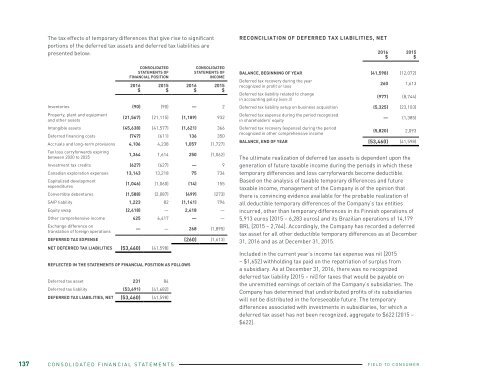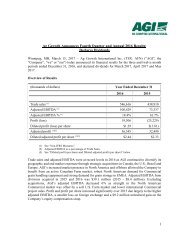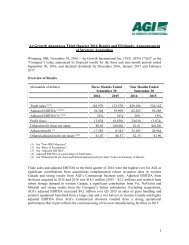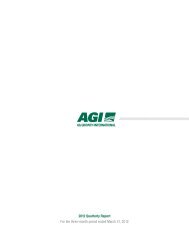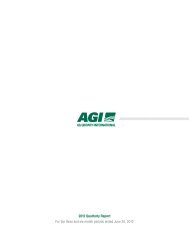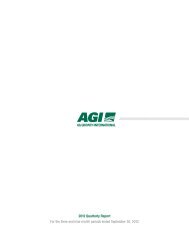2016 Annual Report For Web 7.3MB
Create successful ePaper yourself
Turn your PDF publications into a flip-book with our unique Google optimized e-Paper software.
The tax effects of temporary differences that give rise to significant<br />
portions of the deferred tax assets and deferred tax liabilities are<br />
presented below:<br />
CONSOLIDATED<br />
STATEMENTS OF<br />
FINANCIAL POSITION<br />
CONSOLIDATED<br />
STATEMENTS OF<br />
INCOME<br />
<strong>2016</strong><br />
$<br />
2015<br />
$<br />
<strong>2016</strong><br />
$<br />
2015<br />
$<br />
Inventories (90) (90) — 2<br />
Property, plant and equipment<br />
and other assets<br />
(21,567) (21,115) (1,189) 932<br />
Intangible assets (45,638) (41,577) (1,621) 366<br />
Deferred financing costs (747) (611) 136 350<br />
Accruals and long-term provisions 4,106 4,238 1,057 (1,727)<br />
Tax loss carryforwards expiring<br />
between 2020 to 2035<br />
1,364 1,614 250 (1,062)<br />
Investment tax credits (627) (627) — 9<br />
Canadian exploration expenses 13,143 13,218 75 734<br />
Capitalized development<br />
expenditures<br />
(1,046) (1,060) (14) 155<br />
Convertible debentures (1,588) (2,087) (499) (273)<br />
SAIP liability 1,223 82 (1,141) 796<br />
Equity swap (2,418) — 2,418 —<br />
Other comprehensive income 425 6,417 — —<br />
Exchange difference on<br />
translation of foreign operations<br />
— — 268 (1,895)<br />
DEFERRED TAX EXPENSE (260) (1,613)<br />
NET DEFERRED TAX LIABILITIES (53,460) (41,598)<br />
REFLECTED IN THE STATEMENTS OF FINANCIAL POSITION AS FOLLOWS<br />
Deferred tax asset 231 84<br />
Deferred tax liability (53,691) (41,682)<br />
DEFERRED TAX LIABILITIES, NET (53,460) (41,598)<br />
RECONCILIATION OF DEFERRED TAX LIABILITIES, NET<br />
<strong>2016</strong><br />
$<br />
2015<br />
$<br />
BALANCE, BEGINNING OF YEAR (41,598) (12,072)<br />
Deferred tax recovery during the year<br />
recognized in profit or loss<br />
260 1,613<br />
Deferred tax liability related to change<br />
in accounting policy [note 3]<br />
(977) (8,744)<br />
Deferred tax liability setup on business acquisition (5,325) (23,103)<br />
Deferred tax expense during the period recognized<br />
in shareholders’ equity<br />
— (1,385)<br />
Deferred tax recovery (expense) during the period<br />
recognized in other comprehensive income<br />
(5,820) 2,093<br />
BALANCE, END OF YEAR (53,460) (41,598)<br />
The ultimate realization of deferred tax assets is dependent upon the<br />
generation of future taxable income during the periods in which these<br />
temporary differences and loss carryforwards become deductible.<br />
Based on the analysis of taxable temporary differences and future<br />
taxable income, management of the Company is of the opinion that<br />
there is convincing evidence available for the probable realization of<br />
all deductible temporary differences of the Company’s tax entities<br />
incurred, other than temporary differences in its Finnish operations of<br />
5,913 euros [2015 – 6,283 euros] and its Brazilian operations of 14,179<br />
BRL [2015 – 2,764]. Accordingly, the Company has recorded a deferred<br />
tax asset for all other deductible temporary differences as at December<br />
31, <strong>2016</strong> and as at December 31, 2015.<br />
Included in the current year’s income tax expense was nil [2015<br />
– $1,652] withholding tax paid on the repatriation of surplus from<br />
a subsidiary. As at December 31, <strong>2016</strong>, there was no recognized<br />
deferred tax liability [2015 – nil] for taxes that would be payable on<br />
the unremitted earnings of certain of the Company’s subsidiaries. The<br />
Company has determined that undistributed profits of its subsidiaries<br />
will not be distributed in the foreseeable future. The temporary<br />
differences associated with investments in subsidiaries, for which a<br />
deferred tax asset has not been recognized, aggregate to $622 [2015 –<br />
$622].<br />
Income tax provisions, including current and deferred income tax<br />
assets and liabilities, and income tax filing positions require estimates<br />
and interpretations of federal and provincial income tax rules and<br />
regulations, and judgments as to their interpretation and application<br />
to AGI’s specific situation. The amount and timing of reversals of<br />
temporary differences will also depend on AGI’s future operating<br />
results, acquisitions and dispositions of assets and liabilities. The<br />
business and operations of AGI are complex, and AGI has executed<br />
a number of significant financings, acquisitions, reorganizations and<br />
business combinations over the course of its history. The computation<br />
of income taxes payable as a result of these transactions involves many<br />
complex factors, as well as AGI’s interpretation of and compliance with<br />
relevant tax legislation and regulations. While AGI believes that its tax<br />
filing positions are probable to be sustained, there are a number of tax<br />
filing positions that may be the subject of review by taxation authorities.<br />
Therefore, it is possible that additional taxes could be payable by AGI,<br />
and the ultimate value of AGI’s income tax assets and liabilities could<br />
change in the future, and that changes to these amounts could have a<br />
material effect on these consolidated financial statements.<br />
There are no income tax consequences to the Company attached to<br />
the payment of dividends in either <strong>2016</strong> or 2015 by the Company to its<br />
shareholders.<br />
29. FINANCIAL INSTRUMENTS AND FINANCIAL RISK<br />
MANAGEMENT<br />
[A] MANAGEMENT OF RISKS ARISING FROM FINANCIAL<br />
INSTRUMENTS<br />
AGI’s principal financial liabilities, other than derivatives, comprise<br />
loans and borrowings and trade and other payables. The main purpose<br />
of these financial liabilities is to finance the Company’s operations<br />
and to provide guarantees to support its operations. The Company has<br />
deposits, trade and other receivables and cash and short-term deposits<br />
that are derived directly from its operations. The Company also holds an<br />
available-for-sale investment and enters into derivative transactions.<br />
The Company’s activities expose it to a variety of financial risks: market<br />
risk [including foreign exchange risk and interest rate risk],<br />
credit risk and liquidity risk. The Company’s overall risk management<br />
program focuses on the unpredictability of financial markets and<br />
seeks to minimize potential adverse effects on the Company’s financial<br />
performance. The Company uses derivative financial instruments<br />
to mitigate certain risk exposures. The Company does not purchase<br />
any derivative financial instruments for speculative purposes. Risk<br />
management is the responsibility of the corporate finance function,<br />
which has the appropriate skills, experience and supervision. The<br />
Company’s domestic and foreign operations, along with the corporate<br />
finance function identify, evaluate and, where appropriate, mitigate<br />
financial risks. Material risks are monitored and are regularly<br />
discussed with the Audit Committee of the Board of Directors. The Audit<br />
Committee reviews and monitors the Company’s financial risk-taking<br />
activities and the policies and procedures that were implemented to<br />
ensure that financial risks are identified, measured and managed in<br />
accordance with Company policies.<br />
The risks associated with the Company’s financial instruments are as<br />
follows:<br />
MARKET RISK<br />
Market risk is the risk that the fair value of future cash flows of a<br />
financial instrument will fluctuate because of changes in market prices.<br />
Components of market risk to which AGI is exposed are discussed<br />
below. Financial instruments affected by market risk include trade<br />
accounts receivable and payable, available-for-sale investments and<br />
derivative financial instruments.<br />
The sensitivity analyses in the following sections relate to the position<br />
as at December 31, <strong>2016</strong> and December 31, 2015.<br />
The sensitivity analyses have been prepared on the basis that the<br />
amount of net debt, the ratio of fixed to floating interest rates of the<br />
debt and derivatives and the proportion of financial instruments in<br />
foreign currencies are all constant. The analyses exclude the impact of<br />
movements in market variables on the carrying value of provisions and<br />
on the non-financial assets and liabilities of foreign operations.<br />
The following assumptions have been made in calculating the sensitivity<br />
analyses:<br />
137 CONSOLIDATED FINANCIAL STATEMENTS<br />
FIELD TO CONSUMER<br />
<strong>2016</strong> ANNUAL REPORT<br />
CONSOLIDATED FINANCIAL STATEMENTS 138


